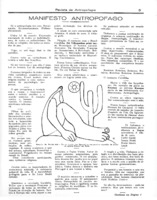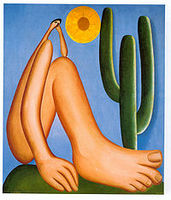Tarsila do Amaral
In 1928, one of the most influential art manifestos was published by Oswald de Andrade, the Anthropophagy Manifesto. In tandem with this manifesto, an art piece was created by the Brazilian artist Tarsila do Amaral – Canibal (1928). Tarsila, having come from a wealthy family, knew little about any form of heritage she may have had and was instead taught art in an Academic Style. Done in a style Tarsila had accumulated from study abroad in Europe (A common trait for many Latin American Artists), the painting screams a belief that had been quietly whispered before: The Latin American Artist was not inferior, and would not back down without a fight.
A representational piece, Canibal alludes to the Manifesto that it was paired with, in that the Latin American Artist would be artistic cannibals who would take from the world that had taken from them culture and customs. Canibal is a mockery of the World ideals of the Latin American Artist; the small head to infer the Latin American Artist’s simple minded nature, the large feet to symbolize their connection with the earth, the sun and cactus to solidify their bonds as a simple, savage people. In many ways, Tarsila was painting a picture that mocked the outside world, and began to create support for an idea that there was more to Latin American art than the art styles that the World embraced heavily.


